Trees Birds Mammals Fish Amphibians Reptiles
Wild Algarve
Bookshop
Leccinum cyaneobasileucum Lannoy & Estadès - Greyshank Bolete
Phylum: Basidiomycota - Class: Agaricomycetes - Order: Boletales - Family: Boletaceae
Distribution - Taxonomic History - Etymology - Identification - Culinary Notes - Reference Sources
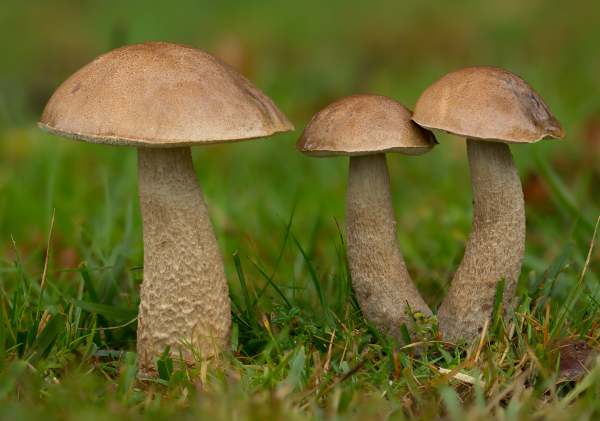
Appearing under birch trees mostly on acid soil, this common summer and autumn bolete is one that even inexperienced fungi foragers are unlikely to confuse with any of the dangerously poisonous gilled mushrooms.
Leccinum cyaneobasileucum is similar in appearance to and often misidentified as the Brown Birch Bolete Leccinum scabrum - and indeed until 1991 these two species were not formally recognised as separate.
Leccinum cyaneobasileucum is one of the most common and widespread of the scaberstalk boletes, but that doesn't mean that its identification is easy. Colours change with age, and most Leccinum boletes change shape as well as colour depending on how wet they are. As with all members of this deceptively difficult group, confident identification of Leccinum cyaneobasileucum requires study of both macroscopic and microscopic features.
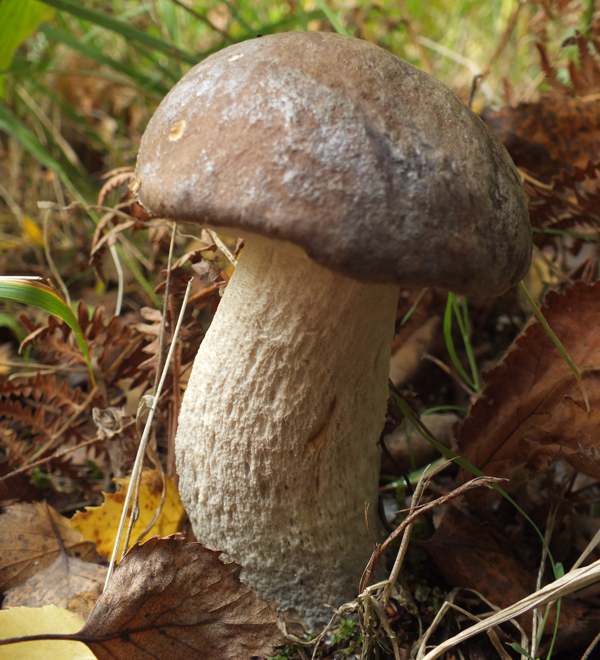
Cap colour is not a key determining feature of this scaberstalk mushroom: it ranges from very pale grey (almost white) through various shades of greyish brown to very dark grey (almost black); however, the general grey tinge and the woolly stem surface, usually bluish towards the slightly swollen base give it a distinctive 'jizz'.
Distribution
Probably far more common in Britain (particularly southern England) and Ireland than its entry in the Fungal Records Database of Britain and Ireland suggests, this boletoid mushroom is also found throughout much of mainland Europe as far north as Denmark. The white form of Leccinum brunneogriseolum shown above was photographed in central France.
Taxonomic history
The white form of this bolete was described in 1991 by Lannoy & Estadès before they recorded brown form, and because initially they gave the white form the specific name Leccinum cyaneobasileucum (reserving Leccinum brunneogriseolum for the more common brown form), under the rules of the international naming convention the binomial scientific name Leccinum cyaneobasileucum takes precedence
Leccinum brunneogriseolum Lannoy & Estadès, and Leccinum brunneogriseolum f. chlorinum Lannoy & Estadès are Synonyms of Leccinum cyaneobasileucum.
Etymology
Leccinum, the generic name, comes from an old Italian word meaning fungus. The specific epithet cyaneobasileucum is a reference to the bluing at the stem base when it is cut through or otherwise damaged.
Identification guide
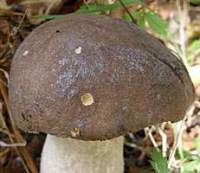 |
Cap
Various shades of grey brown (and there is a very rare albino form), the
cap of Leccinum cyaneobasileucum is usually circular and only occasionally slightly misshapen with its margin somewhat wavy (but rarely as irregular as many large specimens of its lookalike Leccinum scabrum).
The cap surface is very finely tomentose (like velvet), and the margin of the pellicle overhangs the tubes very slightly in young fruitbodies. Initially hemispherical, caps, which become to convex but do not flatten completely, range from 4 to 8cm in diameter when fully developed. |
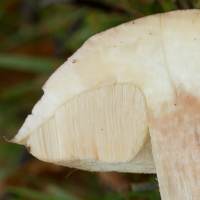 |
Tubes
The circular tubes, typically 0.5mm in diameter, are broadly adnate to the stem; they are 1 to 1.5cm long, off-white with a grey-brown tinge. |
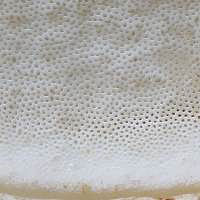 |
Pores
The tubes terminate in pores that are similarly coloured. When bruised, the pores do not undergo a
rapid colour change but gradually turn slightly browner. |
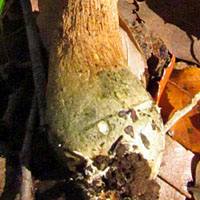 |
Stem
Very pale grey to greyish brown and covered with concolorous scales that turn greyer with age, the stems of Leccinum cyaneobasileucum range from
1 to 2.5cm in diameter and are usually 7 to 14cm tall.
Immature specimens often have barrel-shaped stems; at
maturity stems become more regular in diameter, usually slightly clavate and tapering in towards
the apex. |
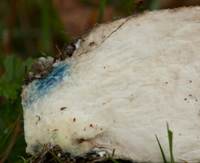 |
The stem flesh is white but sometimes turns slightly pink near the apex when it is cut or broken and always blues (although often only in a very limited region) at the base. The exterior of the stem base usually has a blue tinge that is most noticeable where slugs, snails or bugs have damaged its surface - a helpful identifying feature. |
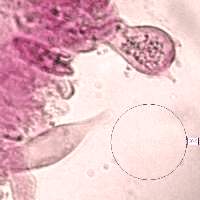 |
Basidia
Mainly 4-spored but usually with some 2-spored basidia.
|
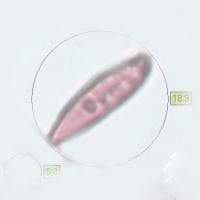 |
Spores
Fusiform, 13-19 x 4-6.5 µm.
Spore print
Pale brown.
Note: Other microscopic characters have to be examined before a specimen can be conclusively recorded as Leccinum cyaneobasileucum. Of particular significance are the caulocystidia and the hyphal structure of the pileipellis (see below). |
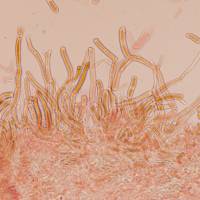 |
Pileipellis
The pileipellis (cap cuticle) usually has numerous cylindrocysts (short, disarticulating hyphal cells, as seen on the left).
Show larger image
|
Odour/taste |
The faint smell and taste are pleasant but not particularly distinctive. |
Habitat & Ecological role |
All Leccinum species are ectomycorrhizal, and most are found only with one tree genus. Leccinum cyaneobasileucum is mycorrhizal only with birch trees (Betula spp.) and in Britain and Ireland this mushroom is found nearly always beneath Silver Birch Betula pendula or Downy Birch Betula pubescens. |
Season |
July to November in Britain and Ireland. |
Similar species |
Leccinum scabrum does not blue in the stem base when cut or broken; it is often rather larger than Leccinum cyaneobasileucum and there are significant differences in microscopic characters that separate these two superficially very similar boletes.
Leccinum versipelle has a much more orange cap and it bruises
blue-green in the stem base. |
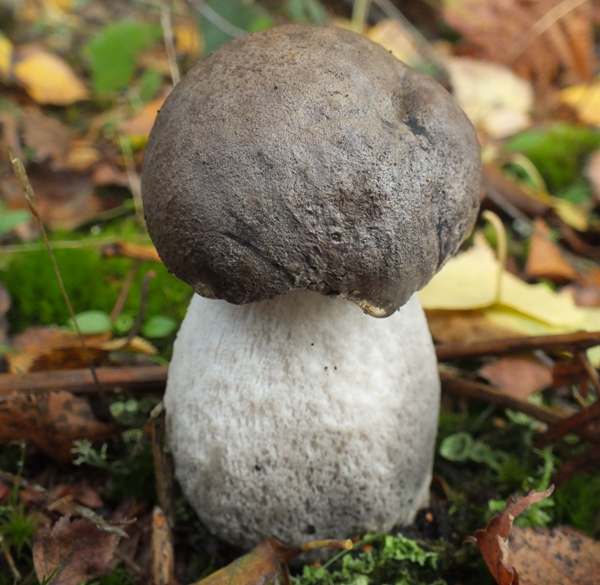
Culinary Notes
Leccinum cyaneobasileucum is generally considered to be a fairly good edible mushroom and can be used in recipes that call for Ceps Boletus edulis (although in both flavour and texture a Cep is superior) or to make up the required quantity if you do not have sufficient Ceps.
Reference Sources
Pat O'Reilly, Fascinated by Fungi, 2016.
Henk C. den Bakker, Barbara Gravendeel & Thomas W. Kuyper (2004). An ITS phylogeny of Leccinum and an analysis of the evolution of minisatellite-like sequences within ITS1; Mycologia, 96(1), 2004, pp. 102-118.
British Boletes, with keys to species, Geoffrey Kibby (self published) 3rd Edition 2012.
Dictionary of the Fungi; Paul M. Kirk, Paul F. Cannon, David W. Minter and J. A. Stalpers; CABI, 2008
Taxonomic history and synonym information on these pages is drawn from many sources but in particular from the British Mycological Society's GB Checklist of Fungi.
Acknowledgements
This page includes pictures kindly contributed by David Kelly.
Top of page...
Fascinated by Fungi. Back by popular demand, Pat O'Reilly's best-selling 450-page hardback book is available now. The latest second edition was republished with a sparkling new cover design in September 2022 by Coch-y-Bonddu Books. Full details and copies are available from the publisher's online bookshop...